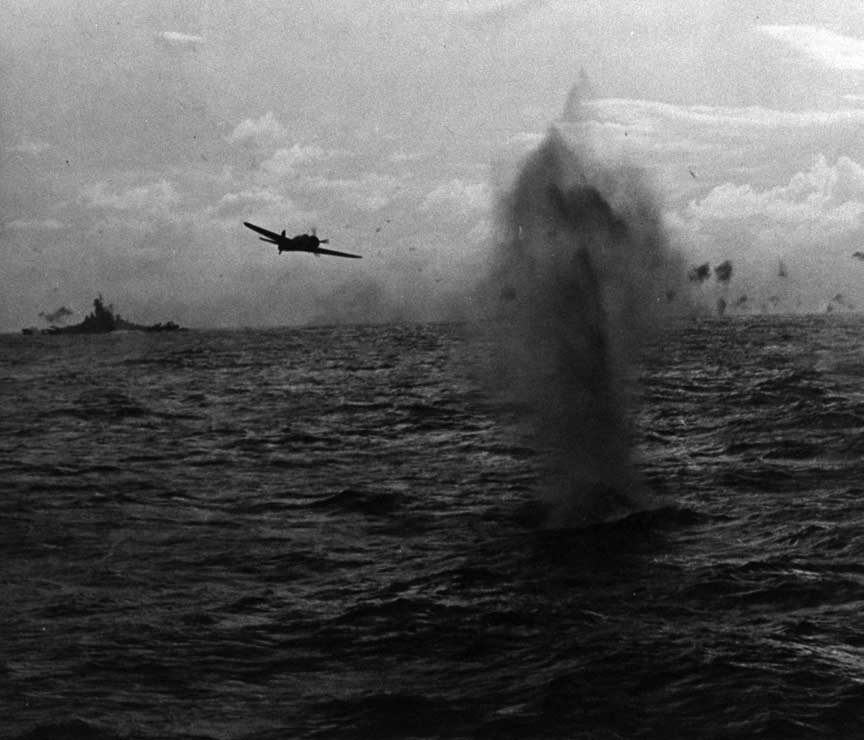June 19th-21st Battle of the Philippine Sea

One of the few Japanese planes to get through
Nine Japanese carriers accompanied by battleships and cruisers attempted to attack an American force led by 15 carriers, covering the landings in Saipan. The battle became known as the "Marina's Turkey Shoot". The Japanese started the battle with 430 carrier aircraft. When it ended they had only 35 carrier aircraft left. Almost all were shot down by the American fighters and anti-aircraft guns, while attempting to attack the US force. In addition, two Japanese fleet carriers were sunk by submarines and one by air attack.On June 12, 1944, the US began air strikes against the Marianas Islands indicated that the US was going to stage an invasion there. The Japanese had spent a year rebuilding their fleet in anticipation of a decisive battle with the American fleet. The invasion of the Marinas endangered the Japanese home islands and therefore was seen as a strategic threat worthy of sending the fleet to defend the Marianas. The Japanese sent nearly their entire fleet three fast carrier, two slower carriers, four light carriers, five battleships,11 heavy cruisers, two light cruisers, 31 destroyers, and 24 submarines. Awaiting the Japanese fleet were seven US Fleet carriers and seven escort carriers, seven fast battleships, eight heavy cruisers, 13 light cruisers, 68 destroyers, and 28 submarines.
The US fleet was larger, but the Japanese hoped that their land-based aircraft and the greater range of their planes would compensate for the larger US fleet. The American, however, had two other advantages, a new secret proximity shell that was able to disable a plane easily and the new aircraft the Hellcats that the S was flying that outclassed the Japanese planes.
On the morning of June 19th, the Japanese found parts of the US fleet and began launching aircraft from Guam to attack. 30 Hellcats were dispatched to intercept the Japanese planes, quickly 35 Japanese aircraft were downed with the loss of only one Hellcat. The Japanese then launched a raid with 68 aircraft from their carriers. They were met by American fighters 70 miles out. 25 Japanese planes were quickly shot down, against the loss of only 1 American plane. As the aircraft got closer to the US fleet, another 16 were shot down six aircraft reached the fleet and caused only minor damage. A second raid was soon detected of 107 aircraft of them 97 were shot down, The third raid of 47 aircraft while less aircraft got shot down they manage to inflict only minor damage. By the end of the day, Japanese losses numbered 350 planes.
Meanwhile, the submarine USS Albacore maneuvered into firing position to the Japanese fleet carrier Taiho the newest Japanese carrier. While only one torpedo reached its mark, poor damage control by the Japanese crew resulted in the carrier sinking later in the day. Later in the day, the submarine USS Cavalla fired six torpedoes at the Japanese carrier Shokaku which quickly sunk.
The next day the Americans located the Japanese fleet, they were at the very extreme of the flight operations of the attacking planes. When they reached the Japanese ships, they sank two oilers and a light carrier, damaging three other carriers. By the time the planes had returned to the US forces, they were running on empty. Admiral Mitscher ordered all of the lights of the ships lit and searchlight aimed at the sky, despite the danger of submarine attack. 80 of the returning planes were lost, but most of the pilots were rescued.
By the end of the battle, the Japanese had lost 433 carrier aircraft and 200 land-based aircraft. The Americans lost 23 aircraft. The action became known as the Marianas Turkey shoot. The superior US aircraft combined with better training had doomed the Japanese. This battle was the end of an effective Japanese naval based air arm. They were never able to make up the loss.
 >
>